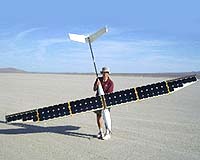| . |  |
. |
Air Force Office of Scientific Research Arlington VA (SPX) Jul 17, 2009 Dye-sensitized solar cells (DSSCs) are expected to power Air Force unmanned aerial vehicles (UAVs) in the future because they are an optimum energy harvesting source that may lead to longer flight times without refueling. The University of Washington's Multidisciplinary University Research Initiative (MURI) project team, with lead researcher Dr. Minoru Taya is working on airborne solar cells by using a flexible film and a thin glass coating with transparent conductive electrodes. He has found that DSSCs made from organic materials, which use (dyes) and moth-eye film, are able to catch photons and convert them into synthesized electrons that can harvest high photon energy. A few years ago the team mounted dye-sensitized solar cells on the wings of a toy airplane. The propeller was effectively powered, but the plane was not able to become airborne because the glass based solar cells they were using were too heavy. Upon experimentation, they decided to use film battery technology, which worked and in fact, enabled the plane to fly. "These kinds of solar cells have more specific power convergence efficiency (PCE), very clean energy and easy scalability to a larger skin area of the craft, as well as, low-temperature processing, which leads to lower costs overall," said Taya. The team is currently working on DSSCs with higher PCEs using bioinspired dyes, which are installed in the wings of the UAV (airborne energy harvesters). "Any airborne energy harvester must satisfy additional requirements, like weight and durability in airborne environments. If those are met, then there may even be longer UAV flight times," said Taya. In the meantime, the engineers are researching the challenges of DSSCs' technology and are seeking to learn how durable they are and how well their technology may integrate with other Air Force vehicles. The team is also trying to determine how to build the solar cells in the wing surface of the aircraft and how to store energy harvested from them. "Some of these challenges will be overcome by the researchers working under this AFOSR MURI within the next two years. In order to make the DSSCs' solar energy harvester transferable to the wings of an UAV, additional engineering tasks remain, which may require another project to be funded for five additional years," Taya said. In the end, the team hopes to reach their goal of developing large, flexible DSSCs with higher energy conversion efficiency. Generally, solar cells that are larger have decreased efficiency. Therefore, the team is using a metal grid, which has high surface resistance and can accelerate electron transport for larger-sized flexible DSSCs while maintaining high efficiency. Share This Article With Planet Earth
Related Links University of Washington UAV News - Suppliers and Technology
 Energy Harvesting For Future UAVs
Energy Harvesting For Future UAVsArlington VA (SPX) Jul 16, 2009 Dye-sensitized solar cells (DSSCs) are expected to power Air Force unmanned aerial vehicles (UAVs) in the future because they are an optimum energy harvesting source that may lead to longer flight times without refueling. The University of Washington's Multidisciplinary University Research Initiative (MURI) project team, with lead researcher Dr. Minoru Taya is working on airborne solar cel ... read more |
|
| The content herein, unless otherwise known to be public domain, are Copyright 1995-2009 - SpaceDaily. AFP and UPI Wire Stories are copyright Agence France-Presse and United Press International. ESA Portal Reports are copyright European Space Agency. All NASA sourced material is public domain. Additional copyrights may apply in whole or part to other bona fide parties. Advertising does not imply endorsement,agreement or approval of any opinions, statements or information provided by SpaceDaily on any Web page published or hosted by SpaceDaily. Privacy Statement |